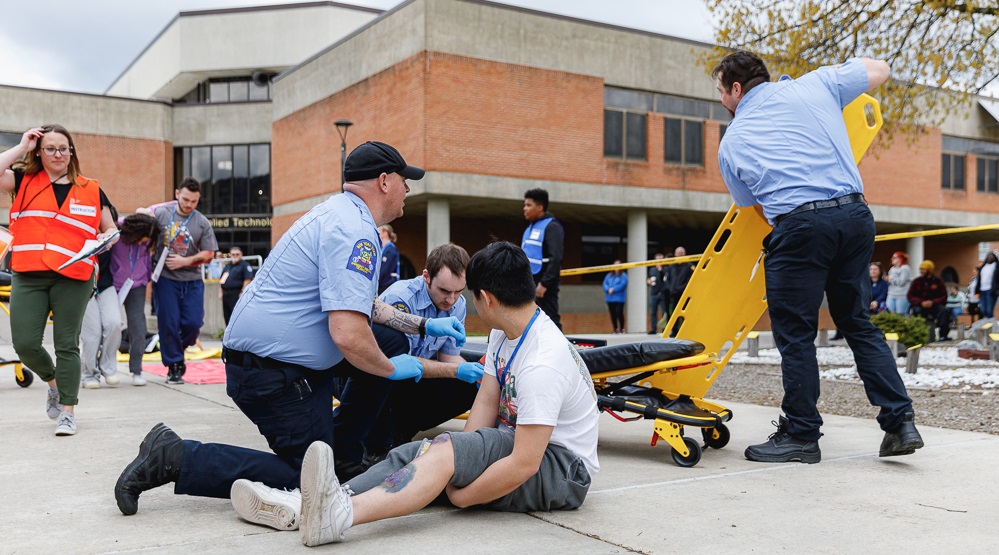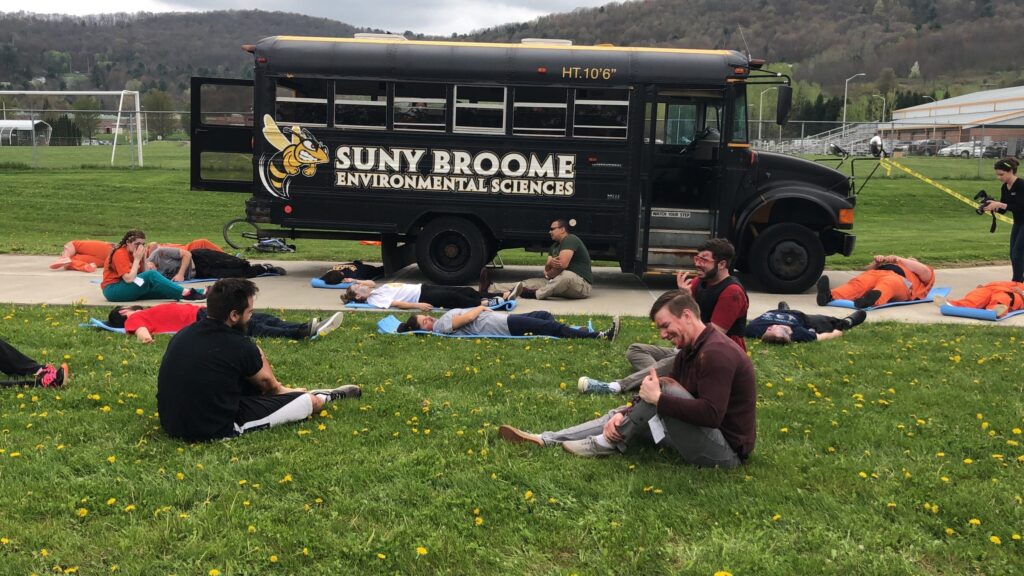The Mock Disaster Committee is comprised of faculty and staff including, but not limited to the following departments: Health Studies, Criminal Justice & Emergency Services, Nursing, Health Information Technology, Radiologic Technology, Physical Therapist Assistant, Dental Hygiene, Clinical Laboratory Technologies, MARCOM, Communications & Media Arts, Chemistry, and Public Safety.
The SUNY Broome Mock Disaster Event is a hands on practical experience for selected students in their field of study and a practical observation experience for students who do not participate but observe. Students are expected to gain valuable insight into operational aspects of their field of study by doing and observing. They will then be able to critically analyze their actions and participation level through use of media, as the event will be documented through video. The event will also be analyzed through use of pre- and post-test student surveys.
Members of the community who participate in the event include, but are not limited to: Chenango Fire, Broome County Health Department, and the Broome County Hazmat Team.
For more information, please contact: Erin O’Hara-Leslie at 778-5161 or oharaleslieek@sunybroome.edu

Prior Years Mock Disaster Videos
SUNY Broome’s ninth Annual Mock Disaster Event, Friday, May 5, 2023
2.5 Minute Video
SUNY Broome’s eighth Annual Mock Disaster Event, Friday, May 3, 2019
4 Minute Video
SUNY Broome’s Seventh Annual Mock Disaster Event, Friday, May 4, 2018
2 Minute Video
SUNY Broome’s Sixth Annual Mock Disaster Event, Friday, May 5, 2017
2 Minute Video
10 Minute Video
SUNY Broome’s Fifth Annual Mock Disaster Event, Friday, May 6, 2016
2 Minute Video
19 Minute Video
Prior Years Mock Disaster Scenarios
2023 Mock Disaster Scenario
The SUNY Broome Rugby team is getting a prestigious athletic award when the propane tank of a nearby food truck that is catering the event explodes. The blast from the explosion creates mass chaos and many significant life-threatening injuries. When emergency services arrive they discover some of the victims towards the north end of the food truck with Americana Fare are covered with an unknown white substance resembling powder. This substance is believed to be a drug, as there is a victim who has overdosed, goes unresponsive, and requires NARCAN. White powder covers 5 of the victims.
The Rugby team, food vendors, and students, are found to be injured, hurt, or deceased.
It was later found that the food truck was used as a drug distribution hub for dealing heroin.
Local police respond, as well as timed responses for fire, ambulances and paramedics. Students from Criminal Justice & Emergency Services will act as “first responders,” securing the scene and starting initial triage as directed by the Incident Commander. The Broome County HazMat team will perform decontamination to the five victims who were exposed to the unknown white chemical powder. Criminal Justice and Emergency Services will act as Unified Disaster Command under the Incident Commander. Two ambulances and a fire truck will respond.
A group of 34 (SUNY Broome students) are found to be injured, hurt, or deceased.
Triage and emergency care will be performed at the scene by Paramedics.. The critically and severely wounded will be taken to the “Hospital” (Nursing Lab Decker 322) where they will be treated by nursing students and directed to the appropriate departments. Those with suspected broken bones will be sent to the Radiology Department (Decker 315) where Radiologic Technology students will perform the necessary x-rays, as ordered by the physicians. A portable x-ray machine will be used for patients who need immediate care or who cannot be transported. Students who are determined to be the walking wounded will be attended to by Paramedics and triaged to appropriate services. Physical Therapist Assistant students will treat designated patients as ordered in the Physical Therapy Lab (Decker 128). The victims who do not survive will be transferred to the morgue (Decker 201-Klee) where Dental Hygiene students will perform forensic exams using dental records for identification. Radiologic Technology students will assist with forensic exams through radiography.
2019 Mock Disaster Scenario
 The annual event, which brings together different departments across campus, serves as training for first responders, future healthcare providers and more – some in areas you might not expect. Hospitality students cooked up lunch, drawing on mass food production skills used by organizations such as the Red Cross, while budding reporters gathered footage for a nightly newscast.As the drill unfolded, a crowd of dental hygiene students watched, clustered together in their maroon scrubs. Their role came a little later in the drill.
The annual event, which brings together different departments across campus, serves as training for first responders, future healthcare providers and more – some in areas you might not expect. Hospitality students cooked up lunch, drawing on mass food production skills used by organizations such as the Red Cross, while budding reporters gathered footage for a nightly newscast.As the drill unfolded, a crowd of dental hygiene students watched, clustered together in their maroon scrubs. Their role came a little later in the drill.Danyel learned about the drill in her chemistry class and volunteered for extra credit, she explained. “I have to seem to be in a lot of agony and pain,” she said. “I’ve never been an actor; it’s kind of outside my box. I’m trying out new things.”
Patients were evaluated in the staged emergency room, with nursing students conducting a variety of life-saving maneuvers at the direction of the scene’s physicians – their professors. In the hallway, nursing and radiologic technology students conducted the delicate transfer of a non-responsive patient from a large bed to a gurney, which was then wheeled into the X-ray room.
“Every experience is going to be a little different. Generally, when you’re dealing with patients who are incarcerated, you often have an officer with you in the room. The exam is usually the same, as long as they’re compliant. If there not, you might have to use other measures,” explained Trisha Illsley, a second-year Rad Tech student. “There is a lot of critical thinking that goes into this.”
View the complete Buzz article Critical thinking, compassionate care: 2019 Mock Disaster is the ultimate test of applied learning
2018 Mock Disaster Scenario
(While the Southern Tier isn’t typically hurricane alley, the scenario may not be as farfetched as it would otherwise seem. The National Weather Service did issue a severe thunderstorm
watch that afternoon for the region and a tornado warning for Oneida County.)
students gathered all the information medical providers would need for patient records. X-Ray Tech students scanned for broken bones and other injuries, while Nursing students stabilized
patients and Clinical Lab Technicians ran needed blood tests. The most unfortunate victims were visited by Dental Hygiene students in a makeshift morgue, where the latter used dental
records to determine identity. Those who recovered enough to regain some mobility were treated by students in the Physical Therapist Assistant program, who evaluated them for gait issues and treated a variety of injury-related issues.“It gives us a first glimpse of what we’ll be getting into,” said Derek Sturdevant, president of the PTA freshman class. “We usually practice with each other, so this also gives us a chance to practice with strangers.”
It was the first mass disaster drill for Ron Mason, a second-year student in the accelerated Paramedic program. He appreciated the opportunity the drill presented for hands-on learning, particularly in how to triage patients in a mass casualty incident. By practicing these skills, students will be ready to respond to real incidents once they’re in the field, he said.
Nancie Regan, a first-year Medical Assisting student, saw the drill from the other side: as a victim. Playing a “walking wounded” wedding guest, she was streaked with fake blood and a bone jutted from her arm. Rather than a gurney or the morgue, she found herself on the grass, her vitals measured by her Medical Assisting peers.
Medical Assisting students tend to the “walking wounded” during the 2018 Mock Environmental Disaster. Paramedic students need to triage victims and determine what order they will be treated in during the 2018 Mock Environmental Disaster.
Being on the other side of a medical emergency is a valuable experience to future care providers. “I’m learning how it feels to put myself in my patient’s shoes, if they were in a disaster,” she said.
The Mock Disaster is also a learning experience for Hospitality Program students. The catering class prepared meals for first-responders, and Event Management students set up the pre-disaster wedding scene. The flowers, billowing table cloths and rose petals looked fit for any swank affair, until they were unceremoniously tipped onto the grass by a roaring tornado.
The students faced some obstacles, just like they would in any true outdoor catering job. The changeable weather and particularly the rising wind made some aspects of preparation challenging, noted Peake, a dual Event Management and Hotel and Restaurant Management major. And, of course, there was the massive nature of it, similar to what the Red Cross would do in responding to disasters.
2017 Mock Disaster Scenario
to denote injuries – carefully lifted onto backboards and gurneys to be whisked to the “hospital” indoors.
as patients are sent onward for X-rays and treatment. Technicians in the blood lab run needed tests. Dental hygiene students attend to the unlucky in the morgue, identifying them through their teeth.
“By order of how critical they are, we will be transporting them to the hospital and the dead patients to the morgue,” he explained prior to the start of the event. Among the elaborately made-up victims were Physical Therapist Assistant students Leah Gilbert and Ross Denkenberger, along with Staff Associate Ellie Rivera. Their characters all had different fates: Gilbert’s victim died, while Rivera and Denkenberger “survived” with injuries – and, in the case of the latter, loudly mourning a “deceased” friend. The exercise was an interesting way to see various school programs in action, Denkenberger said.
While they didn’t have direct contact with “victims,” students in the Clinical Laboratory Technologies also participated in the disaster drill. First-year CLT major Haley Perry worked in the coagulation lab, where she and her colleagues are looking for results concerning blood-clots.
“I might be using these in an actual laboratory during an actual event,” said Perry, holding up some of the equipment she will use. “This helps me build confidence.”
Overall, the drill is a prime example of applied learning, allowing students to bring the skills they learn in the classroom out into the field – and work out the kinks, as needed. “It’s always better to be able to train and practice things in a controlled environment,” Imhauser said.